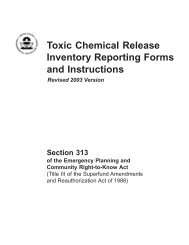(Lockout/Tagout) (revised 2002) OSHA 3120 - Seton
(Lockout/Tagout) (revised 2002) OSHA 3120 - Seton
(Lockout/Tagout) (revised 2002) OSHA 3120 - Seton
You also want an ePaper? Increase the reach of your titles
YUMPU automatically turns print PDFs into web optimized ePapers that Google loves.
• An employee performs hot-tap operations on pressurized<br />
pipelines that distribute gas, steam, water, or petroleum<br />
products, for which the employer shows the following:<br />
– Continuity of service is essential;<br />
– Shutdown of the system is impractical; and<br />
– The employee follows documented procedures and<br />
uses special equipment that provides proven, effective<br />
employee protection.<br />
• The employee is performing minor tool changes or other<br />
minor servicing activities that are routine, repetitive, and<br />
integral to production, and that occur during normal<br />
production operations. In these cases, employees must<br />
have effective, alternative protection.<br />
How does the standard apply to general industry service<br />
and maintenance operations?<br />
The standard applies to the control of hazardous energy when<br />
employees are involved in service or maintenance activities<br />
such as constructing, installing, setting up, adjusting, inspecting,<br />
modifying, and maintaining or servicing machines or equipment.<br />
These activities include lubricating, cleaning or unjamming<br />
machines, and making adjustments or tool changes, where<br />
the employees may be exposed to hazardous energy.<br />
If a service or maintenance activity is part of the normal<br />
production operation, the employee performing the servicing<br />
may be subjected to hazards not normally associated with<br />
the production operation itself. Although machine guarding<br />
provisions in Subpart O of 29 CFR 1910 cover most normal<br />
production operations, workers doing service or maintenance<br />
activities during normal production operations must follow<br />
lockout/tagout procedures if they:<br />
• Remove or bypass machine guards or other safety devices,<br />
• Place any part of their bodies in or near a machine’s point<br />
of operation, or<br />
4<br />
Control of Hazardous Energy (<strong>Lockout</strong>/<strong>Tagout</strong>)
















